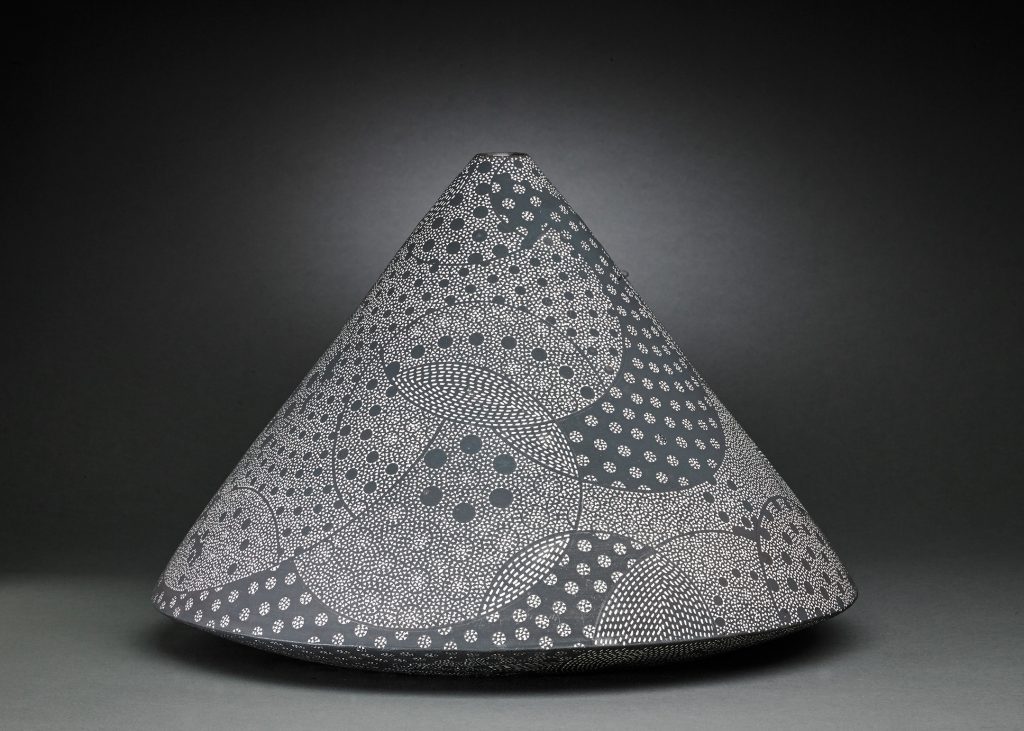THIS EXHIBITION, curated by Tomoko Nagakura, a curator and professor of Japanese art and currently a Research Fellow for the Museum of Fine Arts, Boston, could not have been possible without the gracious cooperation of Carol and Jeffrey Horvitz by allowing access to the Horvitz Collection of Japanese Ceramics. It is from their collection of 20th- and 21st-century Japanese ceramics that the 47 pieces by 40 artists were loaned to create this exhibition.
Objects in the Horvitz Collection of Japanese Ceramics include amongst others, the work of Hamada Shoji, Kiatoji Rosanjin, Yamada Hikaru, and Kazuo Yagi, along with contemporary leaders such as Nakaigawa Yuki, Katsumata Chieko, Hoshino Kayoko, and Akiyama Yo.
They represent the vitality and creativeness of the Japanese tradition of ceramics as art rather than just utilitarian objects, which began in Japan during the late Kamakura and Muromachi periods. It started with the passion for Chinese stoneware bowls of the Jianyao and Longquan types, and other objects (karamono) that served as vital components to the Tea Ceremony, which later included demand for simple Korean rice bowls, brought to Japan as a result of Toyotomi Hideyoshi’s late 16th-century invasion of Korea.
The Tea Ceremony in Japan
Until the advent of Sen no Rikyu in the late 16th century, the Tea Ceremony in the hands of the great feudal lords, was an exercise in opulent display. Rikyu forever changed Tea taste to a heightened sensitivity to nature and nature’s creative processes – unrefined wares of an intensely ‘earthy’ nature. The kilns at Mino, Bizen, Seto, Shino, Oribe, Shigaraki, and others, created bowls in their own styles that evidenced the potter’s ability to bring out the genuineness of the material by its form, surface and sometimes, glaze.
Beginning with the industrialisation and Westernisation of Japan during the reign of the Meiji Emperor (1868-1912), new ideas from the West came to Japan with wide effect, especially in the arts. Ceramics certainly changed as traditional beliefs and attitudes began to be challenged, especially with the belief that ceramics need no longer need be almost exclusively anonymous. Yes, there had been a few ‘name’ potters, such as Nonomura Ninsei and Ogata Kenzan, but by and large, ceramics were anonymous.
The Mingei Movement – Kitaji Rosanjin and Shoji Hamada
Beginning in 1926, the Mingei movement in Japan appreciated the rustic qualities of natural materials and shapes, not unlike the Arts and Crafts Movement in the West. The entire outlook on ceramics changed, starting with the early/mid-20th century artist/potters Kitaoji Rosanjin and Shoji Hamada, both of whom are represented in this distilled, but complete, exhibition. Some of their works are revivals of earlier kilns, but many have an ‘outlook’ of their own. Ceramics were no longer anonymous, but creations of known and recognised individuals.
The Sodeisha Movement
In line with the Mingei tradition came a movement called Sodeisha. The philosophical product of the potter Tomimoto Kenkichi (1886-1963), who was not born in the potter’s tradition, felt that ceramics could be ‘the ultimate abstract art form’ as sculptural objects. In less than a decade following World War II, the Living National Treasure certification was formalised as a means of preserving and protecting individuals whose artistic creations displayed mastery of particular techniques and the works of some of these Living National Treasures are on show here.
Potting, traditionally a man’s realm, began to open to women after World War II and even though there were earlier women potters, such as Rengetsu, it was not until less than 100 years ago that women officially joined the ranks of the potting tradition, and again, some of their works are also included.
The forms clay takes in this exhibition of Japanese contemporary ceramics can range from the geometric, to the sculptural, biomorphic and monumental, displaying the ménage of Mingei, Sodeisha, and the genius of the individual potter.
BY MARTIN BARNES LORBER
Into the Fold: Horvitz Collection of Japanese Ceramics, 7 October to 18 September 2016 at the Harn Museum of Art, University of Florida, SW 34th Street and Hull Road, Gainesville, Florida, http://harn.ufl.edu
A catalogue accompanies this travelling exhibition

